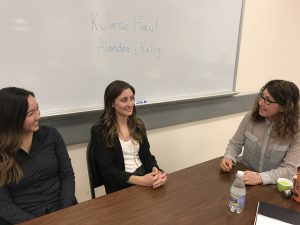On Teaching Mindfulness
“I really enjoyed every single exercise we did this course, it made me feel thankful, calm, and alert. A feeling I don’t normally feel prior to entering this class.” – Anonymous Leadership Communication Student
“I struggled with it but it gave me good techniques to apply to my daily life and my stress management.” – Anonymous Leadership Communication Student
Mindfulness is a topic that I teach in every class in the Leadership Communication course at San Francisco State University. Here is my thinking: the more a leader is aware of themselves and others, the more likely they are to make sound decisions, doing the most good for the greatest amount of people. Therefore, teaching future leaders mindfulness will have a positive effect on the future of the world. That may be a bit of a grandiose statement, but it is my mission. The responses I get in the end-of-term survey, like the two above, inspire me with the immediate impact mindfulness makes.
Over the course of the semester, I teach various forms of meditation and mindfulness to expose students to many options in hope that at least one strikes a chord and they make it a habit. I tie the type of mindfulness to the course content. For example, Metta/Kindness Meditation is taught while learning about Out-Groups, and Visualization is taught at the same time as Creating a Vision.
This semester, the survey results showed that 83 percent of students had no prior experience with mindfulness, 92 percent liked being taught mindfulness, and 96 percent indicated that this instruction made it a better course. I had them rank their preferences of six methods I teach:
Breathing – Center your attention on your breath
Body Awareness – Slowly scan your body, focusing on sensations
Concentration – Focus on a word or phrase repeated silently to yourself
Freeze Game – Stop in the heat of a moment to notice and name internal states
Metta/Kindness – Send goodness to self and others through silent kind phrases
Visualization – Picture a situation, immerse yourself with all senses and notice internal states
Focus on breathing came in as the most popular method, with Visualization being the second most popular and Body Scan and Metta tying for third.
My favorite part of the survey is the free-form responses, so I am sharing a few more here.
“I really enjoyed the experience of doing meditation in class. Majority of the time I’m coming from working a full 8 hour shift and then in traffic for about an hour and a half. This experience really helped me calm down and focus on this class. I also really enjoyed the entire concept of being mindful because it not only helped me with myself but with others also. It really helped me become more aware of emotions, thoughts, and actions because I realized that I am the one in control.”
“I didn’t know that we would be having these every class time and I find it super essential to do because I like to meditate and it feels relaxing to do it towards the end of the day so I can be a little relieved and then carry on to just solely focus on this class. I believe that mindfulness and meditation helps a leader out in many ways and it’s highly important to value that.”
“My mind wanders a lot and I have a lot of thoughts and imagination so to clear out my mind and focus on a singular thing was frustrating.”
As that last comment indicates, not all students enjoy the process. It is not easy in a world of constant digital stimuli to sit quiet for a few moments and turn inward. Not easy, but essential for leaders. So, I will keep teaching mindfulness in my leadership course with the hopes that the impact expands beyond the classroom through the careers of my students.

